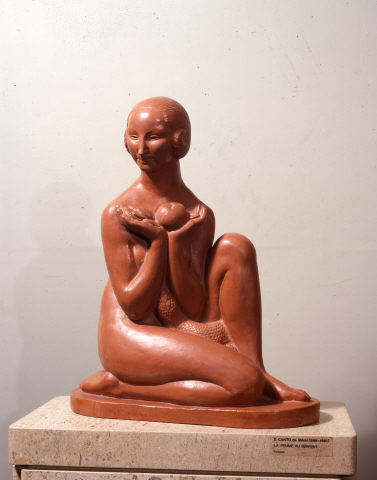
Canto da Maya
La Femme au Serpent
Ponta Delgada, Azores, 1890 – Ponta Delgada, Azores, 1981
Encouraged by his family, Canto da Maya embarked early on a career devoted entirely to the arts. After graduating from High School in Ponta Delgada (1907), he moved to a course at the Escola Superior de Belas-Artes de Lisboa [Lisbon School of Fine Arts] after which he joined the architecture course (1911). He began his work making small satirical sculptures, under the name Ernesto do Canto, and showing at the groundbreaking 1st Portuguese Humourists’ Exhibition (1912), alongside Cristiano Cruz, Jorge Barradas and Almada Negreiros, and aligned himself with the modernist movement. This same year he moved to Paris, where he studied under Antonin Mercié at the École de Beaux-Arts and under Bourdelle at the Académie de la Grande Chaumière. He took part in the Humourists’ Show at the Palais de Glace (1913) and in the 2nd Portuguese Humourists’ Exhibition (1913), with works of a neo-romantic realist nature. In Geneva (1914) and Madrid (1916), he met the two artists he considered his true masters: the symbolist James Vibert, with whom he trained while studying at the Fine Arts school in Geneva, and Julio Antonio, with whom he worked for a year. Vibert introduced him to art nouveau, which led to his interest in terracotta and plaster figures; while his interest in maternal, innocent and sensual figures came from Julio Antonio. At the end of 1916, after some time spent in São Miguel during World War I, he returned to Paris, and settled in Boulogne-sur-Seine, where he embarked on his artistic career with sculptures that grew in both size and expressive dynamism, in the style of Rodin. He was awarded a 2nd Class medal by the SNBA [National Fine Arts Society] together with Maximiliano Alves (1916), and soon after had his first solo show at the Salão Bobone in Lisbon (1919).
The 1920s saw da Maya’s most iconic works, and the maturation of his artistic language within the context of a “return to the roots” of European figurative sculpture. He is internationally acclaimed for the way he highlighted the geometry of forms and for his quest for purity, which referenced ancient Greek sculpture, oriental esotericism and a certain “exoticism” associated with the Azores. His hedonistic thematic universe is permeated with symbols of seduction and sin, and an example of the intimate expressiveness of his female nudes was his first great success, Benit soit le fruit de tes entrailles [Blessed be the fruit of your womb], shown at the Salon de l’ automne, 1922 (in which he regularly took part until 1932). During this period, he was also awarded the Gold Medal at the Paris International Exhibition of Decorative Arts (1925), and completed his prizewinning decorative projects for the Pavillon Pomone (Paris) and the Bristol Club (Lisbon). These are both examples of his continually innovative work in the field of decorative arts throughout the decade, in collaborations with such respected architects as Mallet-Stevens, Paul Follot, Pierre Forrestier, and Raul Lino; in which he developed the art deco aesthetic that set him apart in the art shows of Paris, and that led him to be included in the Contemporary French Art exhibition in Tokyo and Osaka (1926).
His reputation in Paris was consecrated after 1930 and he began to take part more frequently in official shows, starting with the Paris Colonial Exhibition (1931). The French Government bought da Maya’s O Hino do Amor [The Hymn of Love] for the Jeu de Paume (1936), and he won the Grand Prix de Sculpture at the Paris Universal Exhibition (1937) for his reliefs of the Infant D. Henrique, Afonso de Albuquerque and Fernão de Magalhães. With the onset of World War II, and at the peak of his career, he moved from Paris to Lisbon (1938), and from then on began to focus nearly all his time on creating monumental sculptures of national heroes, adapting a modernizing artistic language to the official national academic approach. The bas-relief A Família em Portugal [The Family in Portugal], which appropriated a phrase of Salazar’s, was a key piece in the Portuguese Pavilion at the New York and San Francisco World fair (1939); and the vast sculpted figures of D. Manuel, Vasco da Gama and Álvares Cabral then went on to the Portuguese World fair (1940). He was officially awarded the Ordem Militar de Sant’Iago da Espada (1941), the SPN [Department of National Propaganda] hosted a large retrospective of his work (Lisbon, 1943) and the SNI [Department of National Information] awarded him the Manuel Pereira sculpture prize (1944). Shortly after the end of the war, he returned to Paris, although he continued to visit Lisbon frequently, and exhibited further sculptures commissioned by the Department of Foreign Affairs in the Exposição dos Trabalhos Públicos [Exhibition of Public Works], at the Instituto Superior Técnico (1948).
Although his pace of production slowed over the 1950s, Canto da Maya still took part in the Portuguese representation at the 2nd São Paulo Biennial (1954), which was the same year he settled for good in Ponta Delgada. He was elected an honorary member of the Academia Nacional de Belas Artes de Lisboa [National Lisbon Academy of Fine Arts] (1966), and the Museu Carlos Machado hosted a major retrospective exhibition (1976) and set apart a permanent gallery for his work. When he died in Ponta Delgada (1981), his name was immediately adopted for place names both there and in Lisbon, and his work, which is in several of the major Portuguese and French museums, continues to be the subject of retrospectives and group exhibitions, highlights of which have been exhibitions at the Calouste Gulbenkian Foundation (1990), the Gulbenkian Cultural Centre in Paris (1995), the Bermuda National Gallery (1999), the Maison Grand Place in Brussels, and the Palácio Galveias, Lisbon (2010).
Afonso Ramos
March 2013